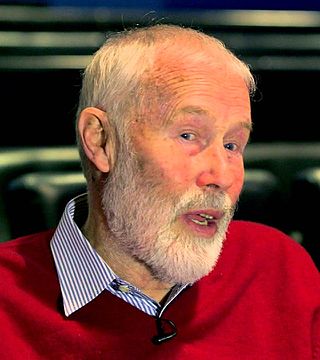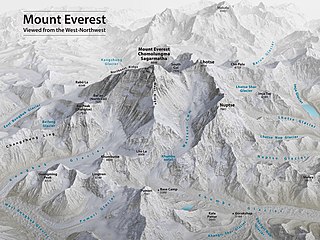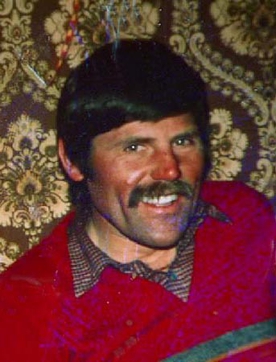
Sir Christian John Storey Bonington, CVO, CBE, DL is a British mountaineer.
Peter Boardman was an English mountaineer and author. He is best known for a series of bold and lightweight expeditions to the Himalayas, often in partnership with Joe Tasker, and for his contribution to mountain literature. Boardman and Tasker died on the North East Ridge of Mount Everest in 1982. The Boardman Tasker Prize for Mountain Literature was established in their memory.

Douglas Keith Scott was an English mountaineer and climbing author, noted for being on the team that made the first ascent of the south-west face of Mount Everest on 24 September 1975. In receiving one of mountaineering's highest honours, the Piolet d'Or Lifetime Achievement Award, his personal style and his climbs were described as "visionary".

Baintha Brakk or The Ogre is a steep, craggy mountain, 7,285 metres (23,901 ft) high, in the Panmah Muztagh, a subrange of the Karakoram mountain range. It is located in Gilgit-Baltistan, Pakistan. It is famous for being one of the hardest peaks in the world to climb: twenty-four years elapsed between the first ascent in 1977 and the second in 2001.

Donald Desbrow Whillans was an English rock climber and mountaineer. He climbed with Joe Brown and Chris Bonington on many new routes, and was considered the technical equal of both.

Eric Earle Shipton, CBE, was an English Himalayan mountaineer.

Mount Asgard is a twin peaked mountain with two flat-topped, cylindrical, rock towers, separated by a saddle. It is located in Auyuittuq National Park, on the Cumberland Peninsula of Baffin Island, Nunavut, Canada. The peak is named after Asgard, the realm of the Æsir (gods) in Norse mythology. Mount Asgard is perhaps the most famous of the Baffin Mountains.
Leo Houlding is a British rock climber and mountaineer.

Mount Everest is the world's highest mountain, with a peak at 8,849 metres (29,031.7 ft) above sea level. It is situated in the Himalayan range of Solukhumbu district, Nepal.

Conrad Anker is an American rock climber, mountaineer, and author. He was the team leader of The North Face climbing team for 26 years until 2018. In 1999, he located George Mallory's body on Everest as a member of a search team looking for the remains of the British climber. Anker had a heart attack in 2016 during an attempted ascent of Lunag Ri with David Lama. He was flown via helicopter to Kathmandu where he underwent emergency coronary angioplasty with a stent placed in his proximal left anterior descending artery. Afterwards he retired from high altitude mountaineering, but otherwise he continues his work. He lives in Bozeman, Montana.

Joe Tasker was a British climber, active during the late 1970s and early 1980s. He died while climbing Mount Everest.
Nick Estcourt was a British climber killed on K2 by an avalanche on the West Ridge route.
Andy Cave is a British mountaineer, mountain guide, and motivational speaker. He was nominated for the Piolet d'Or for his first ascent of the North Face of Changabang in 1997, and won the Boardman Tasker Prize for Mountain Literature in 2005.

The 1975 British Mount Everest Southwest Face expedition was the first to successfully climb Mount Everest by ascending one of its faces. In the post-monsoon season Chris Bonington led the expedition that used rock climbing techniques to put fixed ropes up the face from the Western Cwm to just below the South Summit. A key aspect of the success of the climb was the scaling of the cliffs of the Rock Band at about 8,200 metres (27,000 ft) by Nick Estcourt and Tut Braithwaite.

The British Army Mountaineering Association (AMA) is the governing body for climbing competitions and the representative body for mountaineering in the British Army. It is a member of the British Mountaineering Council and is the largest climbing club in the United Kingdom.

The 1970 British Annapurna South Face expedition was a Himalayan climb that was the first to take a deliberately difficult route up the face of an 8,000-metre mountain. At the time that the expedition set out, in March 1970, the only 8000ers which had been ascended more than once were Everest, Cho Oyu and Nanga Parbat; only Everest and Nanga Parbat had been climbed by a route different from that used on the first ascent.
Marc-André Leclerc was a Canadian rock climber, ice and mixed climber, and alpinist. He is known for his solo ascents–often in winter–of major ice and alpine climbing routes. In 2016, he completed the first winter solo ascents of both Torre Egger in Patagonia and of the Emperor Face of Mount Robson in Canada. In 2018, he was killed in an avalanche on the Mendenhall Towers in Alaska.

Franz Oppurg was an Austrian mountain climber. Having climbed from a young age, he became a mountain guide and rescuer, and did a number of first ascents in the winter of mountains in his native Karwendel. He was also the first climber to achieve a solo ascent of Mount Everest.













